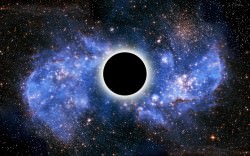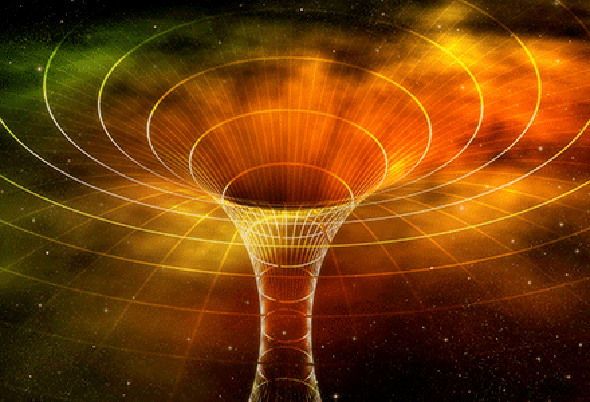That’s the conclusion reached by one researcher from the University of North Carolina: black holes can’t exist in our Universe — not mathematically, anyway.
“I’m still not over the shock,” said Laura Mersini-Houghton, associate physics professor at UNC-Chapel Hill. “We’ve been studying this problem for a more than 50 years and this solution gives us a lot to think about.”
In a news article spotlighted by UNC the scenario suggested by Mersini-Houghton is briefly explained. Basically, when a massive star reaches the end of its life and collapses under its own gravity after blasting its outer layers into space — which is commonly thought to result in an ultra-dense point called a singularity surrounded by a light- and energy-trapping event horizon — it undergoes a period of intense outgoing radiation (the sort of which was famously deduced by Stephen Hawking.) This release of radiation is enough, Mersini-Houghton has calculated, to cause the collapsing star to lose too much mass to allow a singularity to form. No singularity means no event horizon… and no black hole.

At least, not by her numbers.
Read more: How Do Black Holes Form?
So what does happen to massive stars when they die? Rather than falling ever inwards to create an infinitely dense point hidden behind a space-time “firewall” — something that, while fascinating to ponder and a staple of science fiction, has admittedly been notoriously tricky for scientists to reconcile with known physics — Mersini-Houghton suggests that they just “probably blow up.” (Source)
According to the UNC article Mersini-Houghton’s research “not only forces scientists to reimagine the fabric of space-time, but also rethink the origins of the universe.”
Hm.
The submitted papers on this research are publicly available on arXiv.org and can be found here and here.
Read more: What Would It Be Like To Fall Into a Black Hole?
Don’t believe it? I’m not surprised. I’m certainly no physicist but I do expect that there will be many scientists (and layfolk) who’ll have their own take on Mersini-Houghton’s findings (*ahem* Brian Koberlein*) especially considering 1. the popularity of black holes in astronomical culture, and 2. the many — scratch that; the countless — observations that have been made on quite black hole-ish objects found throughout the Universe.
So what do you think? Have black holes just been voted off the cosmic island? Or are the holes more likely in the research? Share your thoughts in the comments!
Want to hear more from Mersini-Houghton herself? Here’s a link to a video explaining her view of why event horizons and singularities might simply be a myth.
Source: UNC-Chapel Hill. HT to Marco Iozzi on the Google+ Space Community (join us!)
Of course this leads me to ask: if there really are “no black holes” then what’s causing the stars in the center of our galaxy to move like this?
*Added Sept. 25: I knew Brian wouldn’t disappoint! Read his post on why “Yes, Virginia, There Are Black Holes.”


Thunderbolts
If Mersini-Houghton is even close to being correct, maybe a ‘black-hole’ is just an object which is infinitesimal close to being a singularity. The structure of the object collapses to the known limit of the universe and no more.
Why can’t I read the comments of others since weeks now?
There is something funny with the constant G:
G = cubic meters per kilogram per second.
1/G = [delta] T per volume mass
So if there are no black holes, then what is Cyg X-1? What are the million solar mass objects at the centers of galaxies? What are they, if not black holes?
I can’t read these comments. All I see is “5 comments… read them below or add one”, and then nothing. I can leave a comment, but not read it afterward or see any other comments.
Using Firefox.
Black holes were never compatible with mathematics in the first place. They existence were always at odds with Euclidian geometry(ex:two parallel lines would never come into contact with one another)
This new(non peer reviewed so far) research only illuminates the long standing contradiction between our analytic and empirical reasoning. (Existence -or non existence- of tangible a priori truths).
Goes to show how those increasing attracts to philosophical inquiry by different fronts undermines our pursuit of truth.
There is no permanence in matter, which is always undergoing change as worlds come into existence and pass away. Matter becomes unorganized after the disintegration of worlds and in the process becomes decontaminated and purified. The various elements become separated, cleansed and reclassified. Matter isn’t created from nothing and cannot disappear. Matter is always being reformed, reorganized and reused. Nothing is wasted, nothing is duplicated and there is no space without something in it. Until matter is organized it is inert and helpless. You have to put into matter some animating principal known everywhere as “The Spark”. When “the spark”or light is removed, matter falls back into it’s original lifeless condition. That light or “spark” is where a knowledge of the truths of the universe lie. No theory. Only pure knowledge. What is the light that when removed causes animated particles of matter to become lifeless and inert? That’s what I would be interested to learn.
About spontaneous creation and conservation of energy
————————————————————————–
Actually the “Vacuum” can also be described as each point as a equal cancellation of positive energy and negative energy electrons with one going below the speed of light and one above the speed of light canceling energies of each other. The equation of energy for particles above light can found at: http://rspa.royalsocietypublishing.org/content/468/2148/4174.abstract and a correction and improvement here: http://www.researchgate.net/publication/265643274_Extended_principle_of_relativity_beyond_speed_of_light_and_a_method_to_push_particles_beyond_the_speed_of_light .
As the vacuum can be represented as cancelling particles above the speed of light and below the speed of light, a slight perturbation in this equilibrium can lead of positive energy photons and a greater perturbation to a electron-positron pair. If the space-time is modeled as photon trajectories as in this paper: https://www.researchgate.net/publication/266143448_Matter-light_duality_and_speed_greater_than_light then the whole space-time and matter can arise out of slight natural perturbation from a perfectly balanced Vacuum/Universe.
A 0 or vacuum is not a mere zero but a perfect balance of canceling energies, which have an automatic tendency to get perturbed (because the phase of the matter wave cannot perfectly cancel) and generate non-zero matter and space-time.
BTW there is a problem with conservation of energy using existing equation. In this paper it shows that using observation by a continuum of observers one can derive a problem the in conservation: https://www.researchgate.net/publication/265643349_Problem_in_the_relativistic_energy_and_momentum_conservation
For some reason I can not see the 8 comments previously submitted.